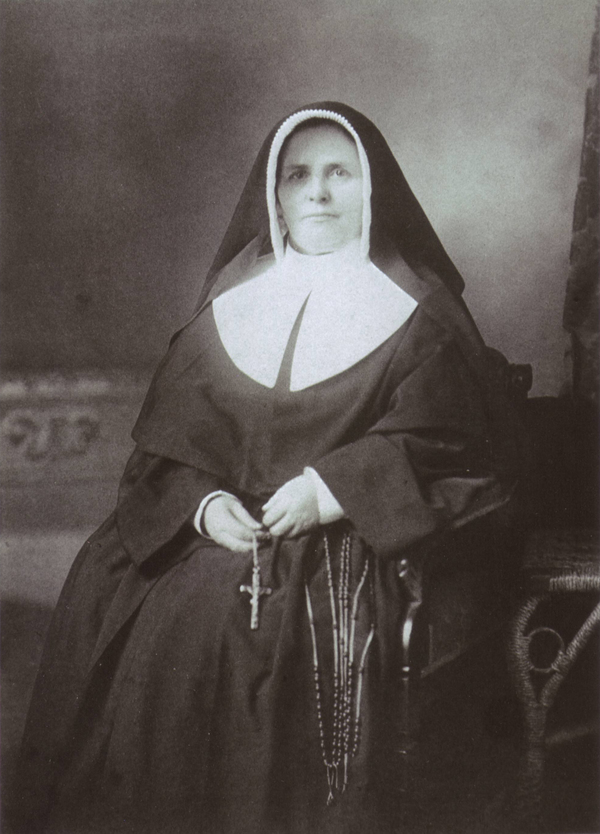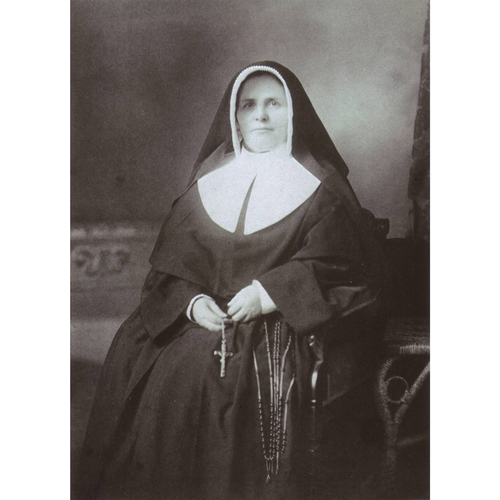
Source: Link
McDONALD (MacDonald, Macdonald), MARY, named Sister Mary Francesca, educator and Sister of Charity of the Immaculate Conception; b. 2 Feb. 1853 in Bouctouche, N.B., daughter of John McDonald, a farmer, and Margaret Dineen; d. 29 Aug. 1935 in Saint John.
Little is known of Mary McDonald’s first 18 years except that she was the eldest in a family that would eventually include six daughters and one son. From modest beginnings she rose to influence the development of women’s educational opportunities in New Brunswick during the late 19th and early 20th centuries.
Her professional life began in October 1871 when she was granted a first-class teaching licence for the locality of Bouctouche. That spring the provincial government of George Luther Hatheway* had passed the controversial Common Schools Act, which mandated tax-supported, non-sectarian education and was vehemently opposed by Roman Catholics. It was therefore in an atmosphere of denominational strife that McDonald began her career. By 1875, however, a compromise would be reached that allowed Catholic schools to operate within the public-school system while retaining their religious orientation [see George Edwin King*; John Sweeny*]. McDonald was evidently well suited to the role she had chosen: in 1884 she was described by district school inspector Valentin Landry* as “one of our most successful teachers.” Her initial pedagogical experience and familiarity with the educational bureaucracy of the day would later prove invaluable after she joined the Sisters of Charity of Saint John.
Like other young, single, female teachers of her era, McDonald boarded in the communities where she taught. In Bouctouche she lived with the prominent Dysart family, probably because her own family resided too far from her school, and in Tracadie, where she worked in the mid 1880s after a stint in Cocagne, she stayed with the Religious Hospitallers of St Joseph at the hospital where they cared for lepers [see Amanda Viger*]. While in Bouctouche, she would have been aware of the presence of the Sisters of Charity, who in 1880 established a convent there, and in all likelihood her decision to join this religious order – on 23 Jan. 1887 in Saint John – was prompted by her acquaintance with the local nuns. They were largely French-speaking, but McDonald read French and no doubt spoke it as well.
McDonald was one of the four dozen or so women who entered the congregation as postulants in the 1880s; only she and a few others were in their thirties. The community, founded in 1854, was still very small three decades later and several of its initial members, including the foundress, Honoria Conway*, were alive and active. As part of her early assignments, McDonald, who would take her final vows in 1889 as Sister Mary Francesca, taught at St Peter’s Girls’ School in Portland (Saint John). By the early 1890s she had been transferred to St Vincent’s School, also for girls, in Saint John, where she served as principal and was assigned originally to teach grades nine and ten. These were high-school-level classes that were not recognized by the Saint John Board of School Trustees since the act of 1871 had made provision for only one secondary school in the city. After a few years Sister Francesca, a woman admired within her religious community for her intellectual gifts, invited the superintendent of schools, Henry Seabury Bridges, to read Virgil and Cicero to her students. By 1902 Bridges was sufficiently impressed with the calibre of the work the pupils were undertaking that he recommended the school trustees recognize the diplomas awarded by St Vincent’s; thus the girls’ secondary school was brought under the umbrella of the board. He had earlier shown his confidence in Sister Francesca by asking her, in 1899, to join the board of examiners for high-school matriculations. Her interest in her pupils extended beyond their years of formal education: in 1902 she established the St Vincent’s Alumnae Association to encourage the continued development of the school’s graduates and to provide them with the same kind of amenities offered by similar academic establishments.
Sister Francesca matched her efforts on behalf of schoolgirls by turning her attention to the needs of the younger members of her community, which by the late 1890s numbered approximately 100 nuns throughout the province. She became the sister in charge of the congregation’s “Study” program; essentially a continuation of the nuns’ equivalent of the provincial Normal School curriculum, it gave instruction in teaching techniques and a continuous upgrading in various subjects.
In 1917 Sister Francesca was awarded an honorary ma from St Francis Xavier College in Antigonish, N.S., in recognition of the “distinguished services of her order in the cause of education and Christian charity.” By this time her community had become a papal institute under the name Sisters of Charity of the Immaculate Conception. Two years later she retired from St Vincent’s and embarked on the creation of a private Catholic boarding school for girls, Mount Carmel Academy in Saint John, to meet the needs of those in remote areas who had no access to schooling beyond the elementary level. Tuition based, it was to operate outside the purview of the public-school board. Sister Francesca was involved in all aspects of its foundation, including, apparently, its design. The academy, which offered both high-school and commercial courses, functioned from the 1920s to the 1960s, when the government of Louis-Joseph Robichaud* introduced the Programme of Equal Opportunity in New Brunswick and set up high schools throughout the province, thereby eliminating the need for a boarding school.
Beyond her commitment to providing secondary schools for young women and to building up her colleagues’ teaching credentials, Sister Francesca’s work reflected the interwar efforts of many Catholic women in North America to promote a feminism that was true to the church but also involved a liberal education: she laid great emphasis on the need for her fellow sisters to attend university. Recalled one nun, “Sister seemed to see what would be demanded of the Sisters in the then distant, or somewhat distant, future.” She appears to have been thwarted initially by the superior general of the congregation, Mother Mary Alphonsus (Joanna Carney), who reportedly “saw no necessity” for the women in her charge to take post-secondary courses. She nevertheless persevered and eventually a number of nuns attended Mount St Vincent College in Rockingham (Halifax). Sister Francesca was unwavering in her desire to secure advanced training for the teaching members of her community. In the 1920s she wrote to the president of the University of New Brunswick in Fredericton, Cecil Charles Jones*, asking that lecturers be sent to Saint John during the summer, and a summer school offering university classes was established there in 1928.
Sister Francesca died in 1935, midway through the decade in which the Sisters of Charity welcomed the largest number of entrants in the community’s entire history. As she lay terminally ill at Mount Carmel Academy, New Brunswick premier Albert Allison Dysart*, who had been a little boy when she boarded at his childhood home, came to see her. Kneeling by her bed, he kissed her, saying, “After my mother she is the one.” A member of the congregation would later recall that, a few days after the premier’s visit to the ailing nun, her confessor, Father Donald MacDougald, “prayed her into heaven.” In 1961 the St Vincent’s Alumnae Association inaugurated the Sister M. Francesca Memorial Scholarship in her honour.
The assistance of the following is gratefully acknowledged: Sister Monica Plante, archivist of the Sisters of Charity of the Immaculate Conception (Saint John); Robert Gilmore and Tom McCaffrey of the PANB; Mary McDevitt, archivist of the Roman Catholic Diocese of Saint John; Kathleen MacKenzie, archivist of St Francis Xavier Univ. (Antigonish, N.S.); and M. C. Havey, archivist of the Congregation of the Most Holy Redeemer (Toronto).
Arch. of the Sisters of Charity of the Immaculate Conception, necrology records, p.4, no.111; new novitiate reg., p.4, no.11; Sr Mary Francesca file. Church of Jesus Christ of Latter-day Saints, “New Brunswick provincial deaths, 1815–1938”: familysearch.org/ark:/61903/1:1:XG8W-PDN (consulted 3 Jan. 2017). PANB, RS115-13/8 (record of licensed teachers, 1842–77). Casket (Antigonish), 17 May 1917: 4. E. W. McGahan, “Charity in the east: sectarianism, ethnicity and gender in Saint John, New Brunswick, schools,” in Changing habits: women’s religious orders in Canada, ed. E. M. Smyth (Ottawa, 2007), 38–68; “The Sisters of Charity of the Immaculate Conception: a Canadian case study,” CCHA, Hist. studies, 61 (1995): 99–133. N.B., Dept. of Education, Annual report of the schools of New Brunswick (Fredericton), 1884–86.
Cite This Article
Elizabeth W. McGahan, “McDONALD (MacDonald, Macdonald), MARY, named Sister Mary Francesca,” in Dictionary of Canadian Biography, vol. 16, University of Toronto/Université Laval, 2003–, accessed December 31, 2025, https://www.biographi.ca/en/bio/mcdonald_mary_16E.html.
The citation above shows the format for footnotes and endnotes according to the Chicago manual of style (16th edition). Information to be used in other citation formats:
| Permalink: | https://www.biographi.ca/en/bio/mcdonald_mary_16E.html |
| Author of Article: | Elizabeth W. McGahan |
| Title of Article: | McDONALD (MacDonald, Macdonald), MARY, named Sister Mary Francesca |
| Publication Name: | Dictionary of Canadian Biography, vol. 16 |
| Publisher: | University of Toronto/Université Laval |
| Year of publication: | 2020 |
| Year of revision: | 2020 |
| Access Date: | December 31, 2025 |



